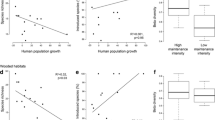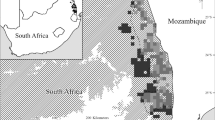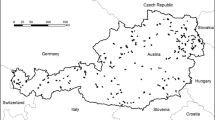Abstract
Land use change—mostly habitat loss and fragmentation—has been recognized as one of the major drivers of biodiversity loss worldwide. According to the habitat amount hypothesis, these phenomena are mostly driven by the habitat area effect. As a result, species richness is a function of both the extent of suitable habitats and their availability in the surrounding landscape, irrespective of the dimension and isolation of patches of suitable habitat. In this context, we tested how the extent of natural areas, selected as proxies of suitable habitats for biodiversity, influences species richness in highly anthropogenic landscapes. We defined five circular sampling areas of 5 km radius, including both natural reserves and anthropogenic land uses, centred in five major industrial sites in France, Italy and Germany. We monitored different biodiversity indicators for both terrestrial and aquatic ecosystems, including breeding birds, diurnal butterflies, grassland vegetation, odonata, amphibians, aquatic plants and benthic diatoms. We studied the response of the different indicators to the extent of natural land uses in the sampling area (local effect) and in the surrounding landscape (landscape effect), identified as a peripheral ring encircling the sampling area. Results showed a positive response of five out of seven biodiversity indicators, with aquatic plants and odonata responding positively to the local effect, while birds, vegetation and diatoms showed a positive response to the landscape effect. Diatoms also showed a significant combined response to both effects. We conclude that surrounding landscapes act as important biodiversity sources, increasing the local biodiversity in highly anthropogenic contexts.





Similar content being viewed by others
References
Angélibert, S., Rosset, V., Indermuehle, N., & Oertli, B. (2010). The pond biodiversity index “IBEM”: a new tool for the rapid assessment of biodiversity in ponds from Switzerland. Part 1. Index development. Limnetica, 29(1), 93–104.
Bailey, D., Schmidt-Entling, M. H., Eberhart, P., Herrmann, J. D., Hofer, G., Kormann, U., & Herzog, F. (2010). Effects of habitat amount and isolation on biodiversity in fragmented traditional orchards. Journal of Applied Ecology, 47(5), 1003–1013.
Bates, D., Maechler, M., Bolker, B., & Walker, S. (2014). lme4: linear mixed-effects models using Eigen and S4. R package version, 1 , 1–6. http://CRAN.R-project.org/package=lme4.
Bey, M.Y., & Ector, L. (2013). Atlas des diatomées des cours d’eau de la region Rhône-Alpes. Tome 1–6. Direction régionale de l’Environnement, de l’Aménagegement et du Logement Rhône-Alpes.
Bibby, C. J., Burgess, N. D., Hill, D. A., & Mustoe, S. H. (2000). Bird census techniques – 2nd edition (302 pp). London, UK: Academic Press.
Billeter, R., Liira, J., Bailey, D., Bugter, R., Arens, P., Augenstein, I., Aviron, S., Baudry, J., Bukacek, R., Burel, F., Cerny, M., De Blust, G., De Cock, R., Diekotter, T., Dietz, H., Dirksen, J., Dormann, C., Durka, W., Frenzel, M., Hamersky, R., Hendrickx, F., Herzog, F., Klotz, S., Koolstra, B., Lausch, A., Le Coeur, D., Maelfait, J. P., Opdam, P., Roubalova, M., Schermann, A., Schermann, N., Schmidt, T., Schweiger, O., Smulders, M. J. M., Speelmans, M., Simova, P., Verboom, J., van Wingerden, W. K. R. E., Zobel, M., & Edwards, P. J. (2008). Indicators for biodiversity in agricultural landscapes: a pan-European study. Journal of Applied Ecology, 45, 141–150.
Blanco, S., Cejudo-Figueiras, C., Álvarez-Blanco, I., Bécares, E., Hoffmann, L., & Ector, L. (2010). Atlas de las Diatomeas de la cuenca del Duero - Diatom Atlas of the Duero Basin (1a ed.382 pp). Universidad de León, León: Área de Publicaciones.
Blanco, S., Cejudo-Figueiras, C., Tudesque, L., Bécares, E., Hoffmann, L., & Ector, L. (2012). Are diatom diversity indices reliable monitoring metrics? Hydrobiologia, 695, 199–206.
Bolpagni, R., & Piotti, A. (2015). The importance of being natural in a human-altered riverscape: role of wetland type in supporting habitat heterogeneity and the functional diversity of vegetation. Aquatic Conservation: Marine and Freshwater Ecosystems. doi:10.1002/aqc.2604.
Bouwman, J., Groenendijk, D., Termaat, T., & Plate, C. (2009). Dutch Dragonfly Monitoring Scheme. A Manual. Report number VS2009.015, Dutch Butterfly Conservation, Wageningen & Statistics Netherlands, Den Haag, Netherlands.
Braun-Blanquet, J. (1964). Pflanzensoziologie, Grundzüge der Vegetationskunde (3. Auflage ed.). Wien: Springer Verlag 865 pages.
Buchwald, R. (1992). Vegetation and dragonfly fauna—characteristics and examples of biocenological field studies. Vegetatio, 101, 99–107.
Chhabra, A., Geist, H., Houghton, R. A., Haberl, H., Braimoh, A. K., Vlek, P. L., Patz, J., Xu, J., Ramankutty, N., Coomes, O., & Lambin, E. F. (2006). Multiple impacts of land-use/cover change. In E. F. Lambin & H. Geist (Eds.), Land-use and land-cover change. Berlin Heidelberg: Springer.
Collinge, S. K., Prudic, K., & Oliver, J. (2003). Effects of local habitat characteristics and landscape context on grassland butterfly diversity. Conservation Biology, 17, 178–187.
Corbet, P., & Brooks, S. (2008). Dragonflies (312 pp). UK: HarperCollins.
R Core Team (2015). R: A Language and Environment for Statistical Computing. R Foundation for Statistical Computing, Vienna. http://www.R-project.org.
Declerck, S., De Bie, T., Ercken, D., Hampel, H., Schrijvers, S., Van Wichelen, J., Gillard, V., Mandiki, R., Losson, B., Bauwens, D., Keijers, S., Vyverman, W., Goddeeris, B., De Meester, L., Brendonck, L., Martens, K., & Keijers, S. (2006). Ecological characteristics of small farmland ponds: associations with land use practices at multiple spatial scales. Biological Conservation, 131(4), 523–532.
Delgado, C., Pardo, I., & García, L. (2012). Diatom communities as indicators of ecological status in Mediterranean temporary streams (Balearic Islands, Spain). Ecological Indicators, 15, 131–139.
Ector, L., Wetzel, C. E., Novais, M. H., & Guillard, D. (2015). Atlas des diatomées des rivières des Pays de la Loire et de la Bretagne (649 pp). Nantes: DREAL Pays de la Loire.
European Commission Environment (2002). Assessment of plans and projects significantly affecting Natura 2000 sites. Methodological guidance on the provisions of Article 6(3) and (4) of the Habitats Directive 92/43/EEC. Luxembourg: Office for Official Publications of the European Communities, ISBN 92–828–1818-7.
European Committee for Standardization. (2003). Water quality guidance standard for the routine sampling and pretreatment of benthic diatoms from rivers, European Standard EN 13946 (14 pp). Brussels: European Committee for Standardization.
European Environmental Agency. (2006). Corine Land Cover. http://www.eea.europa.eu/publications/COR0-landcover
Fahrig, L. (2013). Rethinking patch size and isolation effects: the habitat amount hypothesis. Journal of Biogeography, 40(9), 1649–1663.
Falasco, E., & Bona, F. (2011). Diatom community biodiversity in an Alpine protected area: a study in the Maritime Alps Natural Park. Journal of Limnology, 70(2), 157–167.
Falasco, E., & Bona, F. (2013). Recent findings regarding non-indigenous or poorly known diatom taxa in north-western Italian rivers. Journal of Limnology, 72(1), 35–51.
Falasco, E., Ector, L., Ciaccio, E., Hoffmann, L., & Bona, F. (2012). Alpine freshwater ecosystems in a protected area: a source of diatom diversity. Hydrobiologia, 695(1), 233–251.
Falasco, E., Piano, E., & Bona, F. (2013). Guida al riconoscimento e all’ecologia delle principali diatomee fluviali dell’Italia nord occidentale. Biologia Ambientale, 27(1), 292pp.
Foley, J. A., DeFries, R., Asner, G. P., Barford, C., Bonan, G., Carpenter, S. R., Chapin, F. S., Coe, M. T., Daily, G. C., Gibbs, H. K., Helkowski, J. H., Holloway, T., Howard, E. A., Kucharik, C. J., Monfreda, C., Patz, J. A., Prentice, I. C., Ramankutty, N., & Snyder, P. K. (2005). Global consequences of land use. Science, 309(5734), 570–574.
Hendrickx, F., Maelfait, J. P., van Wingerden, W., Schweiger, O., Speelmans, M., Aviron, S., Augenstein, I., Billeter, R., Bailey, D., Bukacek, R., Burel, F., Diekötter, T., Dirksen, J., Herzog, F., Liira, J., Roubalova, M., Vandomme, V., & Bugter, R. (2007). How landscape structure, land-use intensity and habitat diversity affect components of total arthropod diversity in agricultural landscapes. Journal of Applied Ecology, 44, 340–351.
Herrmann, J. D., Carlo, T. A., Brudvig, L. A., Damschen, E. I., Haddad, N. M., Levey, D. J., Orrock, J. L., & Tewksbury, J. J. (2016). Connectivity from a different perspective: comparing seed dispersal kernels in connected vs. unfragmented landscapes. Ecology, 97(5), 1274–1282.
Hofmann, G., Werum, M., & Lange-Bertalot, H. (2011). Diatomeen im Süßwasser-Benthos von Mitteleuropa (908 pp). Königstein: Koeltz Scientific Books.
Honkanen, M., Sorjanen, A.-M., & Mönkkönen, M. (2011). Deconstructing responses of dragonfly species richness to area, nutrients, water plant diversity and forestry. Oecologia, 166, 457–467.
Hooke, R. L., Martín-Duque, J. F., & Pedraza, J. (2012). Land transformation by humans: a review. GSA Today, 22(12), 4–10.
Johnson, P. T. J., Hoverman, J. T., McKenzie, V. J., Blaustein, A. R., & Richgels, K. L. D. (2013). Urbanization and wetland communities: applying metacommunity theory to understand the local and landscape effect. Journal of Applied Ecology, 50, 34–42.
Kappes, H., Sundermann, A., & Haase, P. (2011). Distant land use affects terrestrial and aquatic habitats of high naturalness. Biodiversity and Conservation, 20(10), 2297–2309.
Kleijn, D., Baquero, R. A., Clough, Y., Diaz, M., Esteban, J. D., Fernández, F., Gabriel, D., Herzog, F., Holzschuh, A., Jöhl, R., Knop, E., Kruess, A., Marshall, E. J. P., Steffan-Dewenter, I., Tscharntke, T., Verhulst, J., West, T. M., & Yela, J. L. (2006). Mixed biodiversity benefits of agri-environment schemes in five European countries. Ecology Letters, 9(3), 243–254.
Kleijn, D., Kohler, F., Báldi, A., Batáry, P., Concepción, E. D., Clough, Y., Díaz, M., Gabriel, D., Holzschuh, A., Knop, E., Kovács, A., Marshall, E. J. P., Tscharntke, T., & Verhulst, J. (2009). On the relationship between farmland biodiversity and land-use intensity in Europe. Proceedings of the Royal Society of London B: Biological Sciences, 276(1658), 903–909.
Knop, E. (2016). Biotic homogenization of three insect groups due to urbanization. Global Change Biology, 22, 228–236.
Krammer, K. (1997a). Die cymbelloiden Diatomeen. Teil 1. Allgemeines und Encyonema Part. Bibliotheca Diatomologica, 36, 382 pp.
Krammer, K. (1997b). Die cymbelloiden Diatomeen. Teil 2. Encyonema part, Encyonopsis and Cymbellopsis. Bibliotheca Diatomologica, 37, 469 pp.
Krammer, K. (2002). Cymbella. In H. Lange-Bertalot (Ed.), Diatoms of Europe (3rd ed.). Rugell: A.R.G. Gantner Verlag KG 584pp.
Krammer, K. (2003). Cymbopleura, Delicata, Navicymbula, Gomphocymbellopsis, Afrocymbella. In H. Lange-Bertalot (Ed.), Diatoms of Europe (4th ed.). Rugell: ARG Gantner Verlag KG 530pp.
Krammer, K., & Lange-Bertalot, H. (1986). Bacillariophyceae Teil: Naviculaceae. 1. In H. Ettl, J. Gerloff, H. Heynig, & D. Mollenhauer (Eds.), Süsswasserflora von Mitteleuropa. 2. Stuttgart: Fischer Verlag 876 pp.
Krammer, K., & Lange-Bertalot, H. (1988). Bacillariophyceae Teil: Bacillariaceae, Epithemiaceae, Surirellaceae. 2. In H. Ettl, J. Gerloff, H. Heynig, & D. Mollenhauer (Eds.), Süsswasserflora von Mitteleuropa. 2. Stuttgart: Fischer Verlag 610 pp.
Krammer, K., & Lange-Bertalot, H. (1991a). Bacillariophyceae Teil: Centrales, Fragilariaceae, Eunotiaceae. 3. In H. Ettl, J. Gerloff, H. Heynig, & D. Mollenhauer (Eds.), Süsswasserflora von Mitteleuropa. 2. Stuttgart: Fischer Verlag 598 pp.
Krammer, K., & Lange-Bertalot, H. (1991b). Bacillariophyceae Teil: Achnanthaceae. Kritische Erg.anzungen zu Navicula (Lineolatae) und Gomphonema. 4. In H. Ettl, J. Gerloff, H. Heynig, & D. Mollenhauer (Eds.), Süsswasserflora von Mitteleuropa. 2. Stuttgart: Fischer Verlag 437 pp.
Lange-Bertalot, H. (2001). Navicula sensu stricto, 10 Genera separated from Navicula sensu lato, Frustulia. In H. Lange-Bertalot (Ed.), Diatoms of Europe. 2. Rugell: A.R.G. Gantner Verlag K.G 526 pp.
Manning, P., Gossner, M. M., Bossdorf, O., Allan, E., Zhang, Y. Y., Prati, D., Blüthgen, N., Boch, S., Böhm, S., Börschig, C., Jung, K., Klaus, V. H., Klein, A. M., Kleinebecker, T., Krauss, J., Lange, M., Müller, J., Pašalić, E., Socher, S. A., Tschapka, M., Türke, M., Weiner, C., Werner, M., Gockel, S., Hemp, A., Renner, S. C., Wells, K., Buscot, F., Kalko, E. K. V., Linsenmair, K. E., Weisser, W. W., & Hölzel, N. (2015). Grassland management intensification weakens the associations among the diversities of multiple plant and animal taxa. Ecology, 96(6), 1492–1501.
McKinney, M. L. (2008). Effects of urbanization of species richness: a review of plants and animals. Urban Ecosystems, 11, 161–176.
Menetrey, N., Oertli, B., & Lachavanne, J. B. (2011). The CIEPT: a macroinvertebrate-based multimetric index for assessing the ecological quality of Swiss lowland ponds. Ecological Indicators, 11, 590–600.
Millennium Ecosystem Assessment (2005). Ecosystems and Human Well-being: Synthesis. Island Press, Washington DC. www.millenniumassessment.org/documents/ document.356.aspx.pdf.
Oertli, B., Auderset Joye, D., Castella, E., Juge, R., Lehmann, A., & Lachavanne, J. B. (2005). PLOCH: a standardized method for sampling and assessing the biodiversity in ponds. Aquatic Conservation: Marine and Freshwater Ecosystems, 15(6), 665–679.
Overmars, K. P., Schulp, C. J., Alkemade, R., Verburg, P. H., Temme, A. J., Omtzigt, N., & Schaminée, J. H. (2014). Developing a methodology for a species-based and spatially explicit indicator for biodiversity on agricultural land in the EU. Ecological Indicators, 37, 186–198.
Parris, K. M. (2016). Ecology of urban environments. Chichester, West Sussex, UK: Wiley-Blackwell.
Pignatti S. (1982). Flora d’Italia. Edagricole, 2324 pp.
Pollard, E., & Yates, T.J. (1993). Monitoring butterflies for ecology and conservation. The British butterfly monitoring scheme. Springer Science & Business Media, 274 pp.
Quantum GIS Development Team (2015). Quantum GIS Geographic Information System. Open Source Geospatial Foundation Project. http://qgis.osgeo.org.
Reichardt, E. (1999). Zur Revision der Gattung Gomphonema. Die Arten um G. affine/insigne, G. angustum/micropus, G. acuminatum sowie gomphonemoide Diatomeen aus dem Oberoligozän in Böhmen. In H. Lange-Bertalot (Ed.), Iconographia Diatomologica. 8. Rugell: A.R.G. Gantner Verlag K.G.
Rott, E., Binder, N., Van Dam, H., Ortler, K., Pall, K., Pfister, P., & Pipp, E. (1999). Indikationslisten für Aufwuchsalgen. Teil 2. Trophieindikation und autökologische Anmerkungen, Bundesministerium für Land- und Forstwirtschaft, Wien, pp. 1–248.
Sala, O. E., Chapin, F. S., Armesto, J. J., Berlow, E., Bloomfield, J., Dirzo, R., Huber-Sanwald, E., Huenneke, L. F., Jackson, R. B., Kinzig, A., Leemans, R., Lodge, D. M., Mooney, H. A., Oesterheld, M., Poff, N. L., Sykes, M. T., Walker, B. H., Walker, M., & Wall, D. H. (2000). Global biodiversity scenarios for the year 2100. Science, 287(5459), 1770–1774.
Schmidt, B. R. (2005). Monitoring the distribution of pond-breeding amphibians when species are detected imperfectly. Aquatic Conservation: Marine and Freshwater Ecosystems, 15(6), 681–692.
Siqueira, T., Bini, L. M., Thomaz, S. M., & Fontaneto, D. (2015). Biodiversity analyses: are aquatic ecologists doing any better and differently than terrestrial ecologists? Hydrobiologia, 750, 5–12.
Smith, A. C., Koper, N., Francis, C. M., & Fahrig, L. (2009). Confronting collinearity: comparing methods for disentangling the effects of habitat loss and fragmentation. Landscape Ecology, 24(10), 1271–1285.
Tudesque, L., Tisseuil, C., & Lek, S. (2014). Scale-dependent effects of land cover on water physico-chemistry and diatom-based metrics in a major river system, the Adour-Garonne basin (south western France). Science of the Total Environment, 466-467, 47–55.
Turrini, T., & Knop, E. (2015). A landscape ecology approach identifies important drivers of urban biodiversity. Global Change Biology, 21(4), 1652–1667. doi:10.1111/gcb.12825.
Tutin, T. G., Heywood, V. H., Burges, N. A., Valentine, D. H., Walters, S. M., & Webb, D. A. (2001). Flora Europaea (2392 pp). Cambridge University Press.
UNI EN 14407: 2004. (2004). Qualità dell'acqua - Linea guida per l'identificazione, il conteggio e la classificazione di campioni di diatomee bentoniche da acque correnti. http://webstore.uni.com/unistore/public/productdetails?productId=UNIN1440700!EEN.
UNI EN 15460: 2007. (2007). Water Quality - Guidance Standard for the Surveying of Macrophytes in Lakes. http://shop.standards.ie/nsai/details.aspx?ProductID=691842
van Dam, H., Mertens, A., & Sinkeldam, J. (1994). A coded checklist and ecological indicator values of freshwater diatoms from the Netherlands. Netherlands Journal of Aquatic Ecology, 28, 117–133.
van Swaay, C.A.M., Brereton, T., Kirkland, P., & Warren, M.S. (2012). Manual for Butterfly Monitoring. Report VS2012.010, De Vlinderstichting/Dutch Butterfly Conservation, Butterfly Conservation UK & Butterfly Conservation Europe, Wageningen.
van Swaay, C., van Strien, A., Aghababyan, K., Astrom, S., Botham, M., Brereton, T., Chambers, P., Collins, S., Domenech Ferre, M., Escobes, R., Feldmann, R., Fernandez-Garcia, J. M., Fontaine, B., Goloshchapova, S., Gracianteparaluceta, A., Harpke, A., Heliola, J., Khanamirian, G., Julliard, R., Kuhn, E., Lang, A., Leopold, P., Loos, J., Maes, D., Mestdagh, X., Monasterio, Y., Munguira, M. L., Murray, T., Musche, M., Ounap, E., Pettersson, L., Popoff, S., Prokofev, I., Roth, T., Roy, D., Settele, J., Stefanescu, C., Svitra, G., Teixeira, S. M., Tiitsaar, A., Verovnik, R., & Warren, M. (2015). The European Butterfly Indicator for grassland species: 1990–2013. Wageningen, The Netherlands, De Vlinderstichting, 37 pp. (Report VS2015.009).
Vitousek, P. M., Mooney, H. A., Lubchenco, J., & Melillo, J. M. (2008). Human domination of Earth’s ecosystems. In Urban Ecology. Springer US. pp., 3–13.
Winsa, M., Bommarco, R., Lindborg, R., Marini, L., & Öckinger, E. (2015). Recovery of plant diversity in restored semi-natural pastures depends on adjacent land use. Applied Vegetation Science, 18(3), 413–422.
Wright, C. K., & Wimberly, M. C. (2013). Recent land use change in the western Corn Belt threatens grasslands and wetlands. Proceedings of the National Academy of Sciences, 110(10), 4134–4139.
Zuur, A. F., Ieno, E. N., Walker, N. J., Savaliev, A. A., & Smith, G. M. (2009). Mixed effect models and extensions in ecology with R. Berlin: Springer 574 pp.
Zuur, A. F., Ieno, E. N., & Elphick, S. C. (2010). A protocol for data exploration to avoid common statistical problem. Methods in Ecology and Evolution, 1(1), 3–14. doi:10.1111/j.2041-210X.2009.00001.x.
Acknowledgements
We are grateful to FCA and CNH Industrial who involved us in this project and for financing and supporting this research and to Studio Fieschi that collaborated with us on this project. We would like to thank all the staff of all industrial sites for their hospitality and for kindly authorizing our research activities and joining us in the fieldwork. We also thank Barbara Rizzioli, Nestor Viñals, Lorenzo Boggia, Dario Masante, Giacomo Assandri, Alberto Doretto, Sabrina Mossino and Davide Giuliano who helped us in collecting data, and Stefano Mammola and Frederik Hendrickx for their suggestions concerning statistical analysis.
Author information
Authors and Affiliations
Corresponding author
Electronic supplementary material
ESM 1
(PDF 693 kb)
Rights and permissions
About this article
Cite this article
Piano, E., Isaia, M., Falasco, E. et al. Local versus landscape spatial influence on biodiversity: a case study across five European industrialized areas. Environ Monit Assess 189, 126 (2017). https://doi.org/10.1007/s10661-017-5824-7
Received:
Accepted:
Published:
DOI: https://doi.org/10.1007/s10661-017-5824-7




